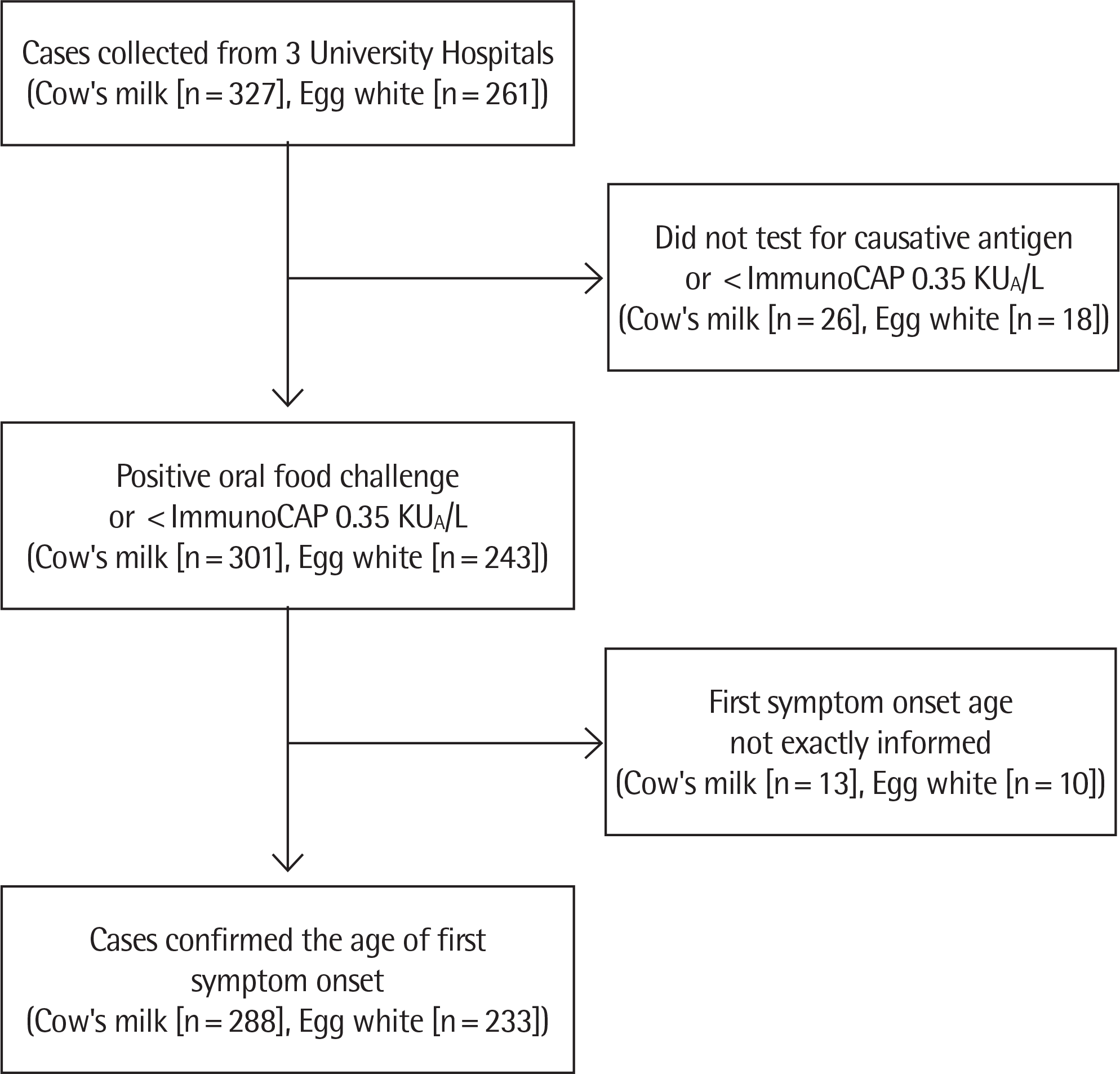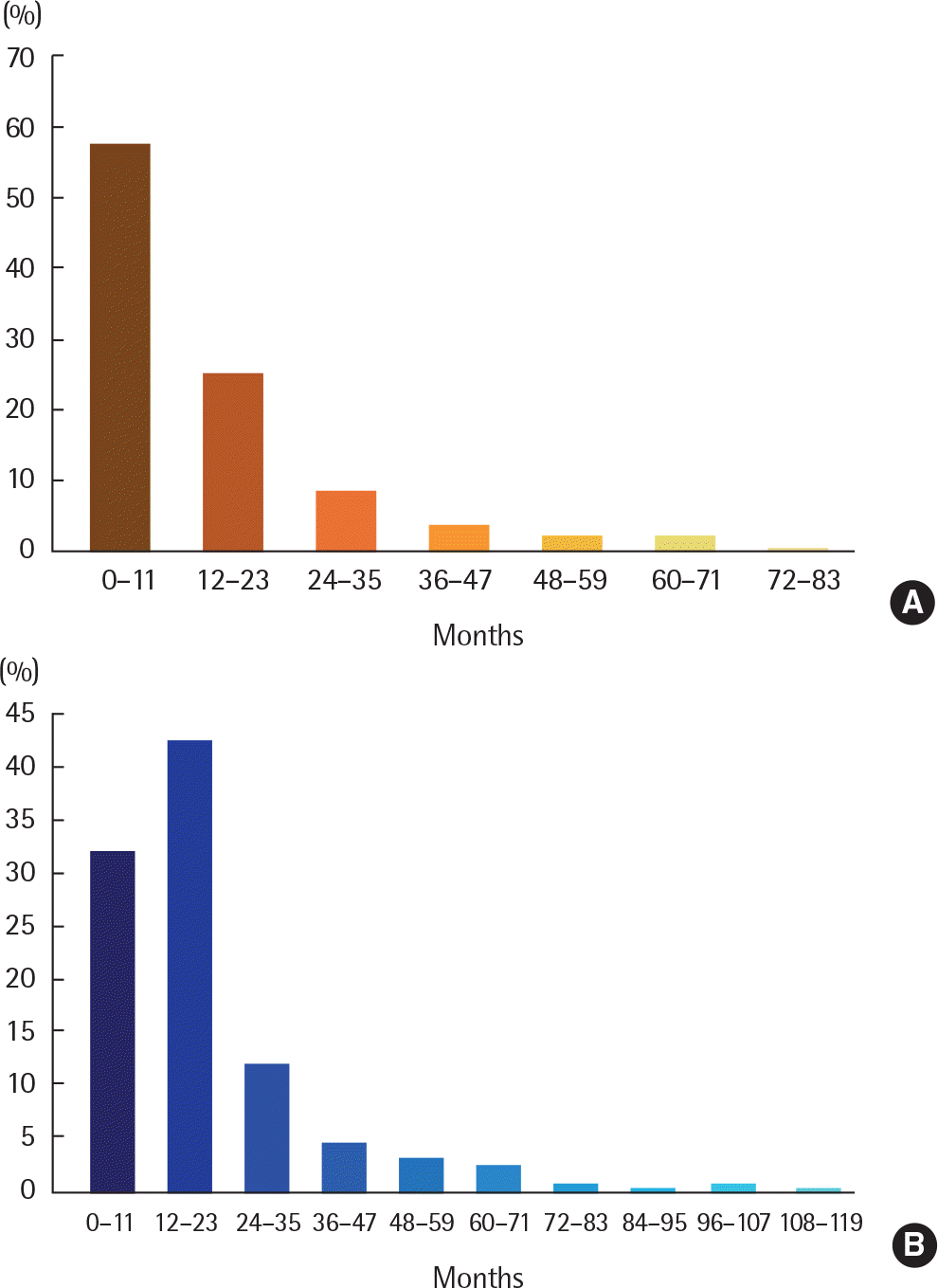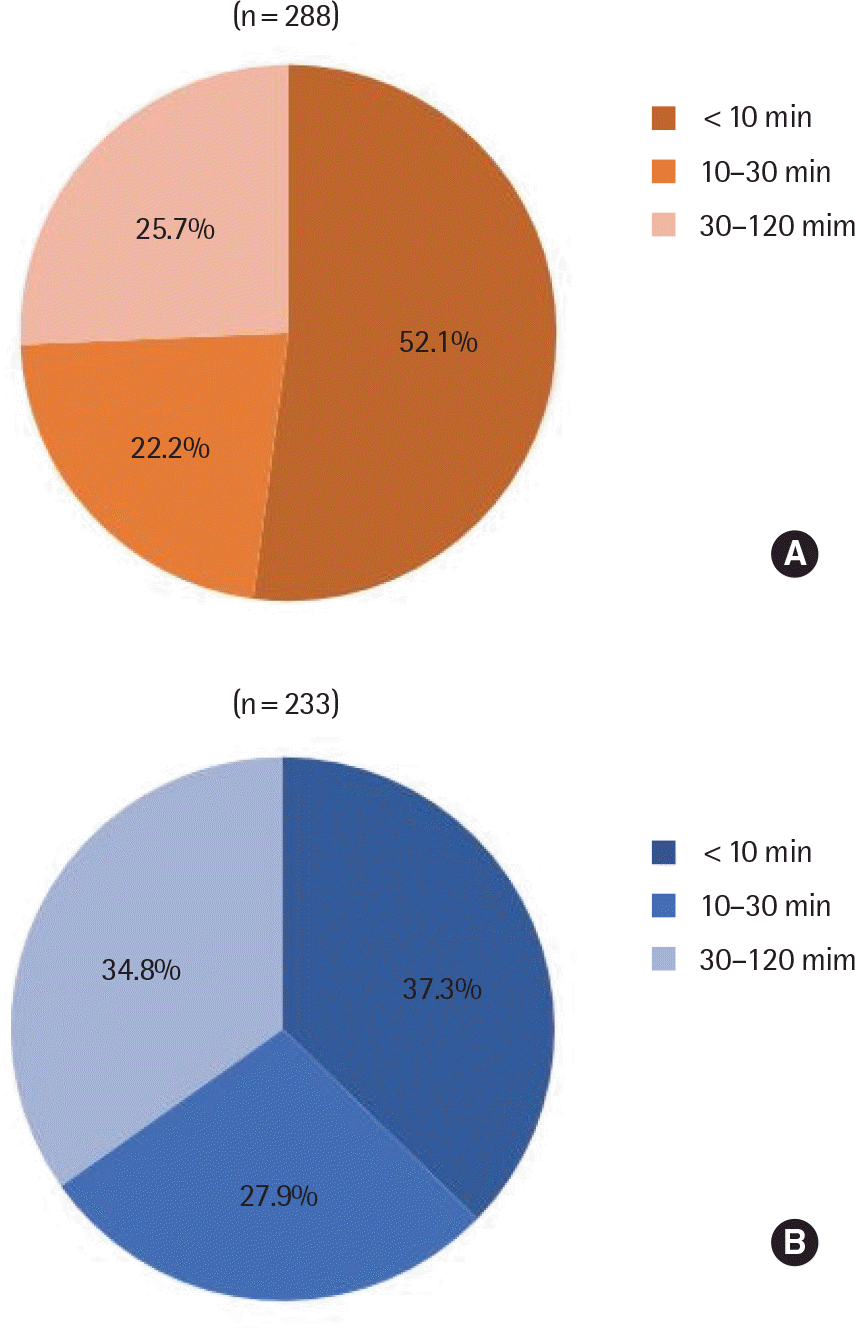Abstract
Purpose
The aim of this study was to evaluate the details of the clinical characteristics and food exposure types at the first symptom onset in immediate-type cow's milk allergy (CMA) and egg white allergy (EWA) in Korean children.
Methods
This study included children with immediate-type CMA (n=288) or EWA (n=233) with symptom onset time of 2 hours or less, who visited Samsung Medical Center, Ajou University Hospital, and Soonchunhyang University Seoul Hospital between September 2014 and August 2015. The details of clinical features and food exposure types at the first symptom onset were evaluated by retrospective medical record review using a standardized case report form.
Results
The median ages of first symptom onset were 10 months in CMA and 12 months in EWA. The most common types of exposure at the first symptom in CMA were formula milk (29.5%) and milk (29.5%), followed by cheese (17.7%) and yogurt (14.2%). The most common type of exposure in EWA was boiled eggs (35.6%), followed by rice/porridge/soup containing eggs (27.5%), pan-fried eggs (17.6%), and baked goods (9.9%). Cutaneous symptoms were most common in both CMA and EWA, and anaphylaxis was no-ticed in 36.1% and 30.3%, respectively. Baked goods containing milk or eggs also induced anaphylaxis. The symptom onset time was less than 30 minutes in the majority of patients and the most common place of occurrence was home in both CMA and EWA.
REFERENCES
1. Gupta RS, Springston EE, Warrier MR, Smith B, Kumar R, Pongracic J, et al. The prevalence, severity, and distribution of childhood food allergy in the United States. Pediatrics. 2011; 128:e9–17.

2. Liu AH, Jaramillo R, Sicherer SH, Wood RA, Bock SA, Burks AW, et al. National prevalence and risk factors for food allergy and relationship to asthma: results from the National Health and Nutrition Examination Survey 2005-2006. J Allergy Clin Immunol. 2010; 126:798–806.e13.

4. Jeong K, Kim J, Ahn K, Lee SY, Min TK, Pyun BY, et al. Age-based causes and clinical characteristics of immediate-type food allergy in Korean children. Allergy Asthma Immunol Res. 2017; 9:423–30.

5. Park M, Kim D, Ahn K, Kim J, Han Y. Prevalence of immediate-type food allergy in early childhood in seoul. Allergy Asthma Immunol Res. 2014; 6:131–6.

6. Cummings AJ, Knibb RC, King RM, Lucas JS. The psychosocial impact of food allergy and food hypersensitivity in children, adolescents and their families: a review. Allergy. 2010; 65:933–45.

7. Luyt D, Ball H, Makwana N, Green MR, Bravin K, Nasser SM, et al. BSA-CI guideline for the diagnosis and management of cow's milk allergy. Clin Exp Allergy. 2014; 44:642–72.

8. Monks H, Gowland MH, MacKenzie H, Erlewyn-Lajeunesse M, King R, Lucas JS, et al. How do teenagers manage their food allergies? Clin Exp Allergy. 2010; 40:1533–40.

9. Des Roches A, Nguyen M, Paradis L, Primeau MN, Singer S. Tolerance to cooked egg in an egg allergic population. Allergy. 2006; 61:900–1.

10. Nowak-Wegrzyn A, Bloom KA, Sicherer SH, Shreffler WG, Noone S, Wanich N, et al. Tolerance to extensively heated milk in children with cow's milk allergy. J Allergy Clin Immunol. 2008; 122:342–7. 347.e1-2.

11. Lambert R, Grimshaw KE, Ellis B, Jaitly J, Roberts G. Evidence that eating baked egg or milk influences egg or milk allergy resolution: a systematic review. Clin Exp Allergy. 2017; 47:829–37.

12. Savage J, Sicherer S, Wood R. The natural history of food allergy. J Allergy Clin Immunol Pract. 2016; 4:196–203.

13. Leonard SA, Caubet JC, Kim JS, Groetch M, Nowak-Węgrzyn A. Baked milk- and egg-containing diet in the management of milk and egg allergy. J Allergy Clin Immunol Pract. 2015; 3:13–23.

14. Deschildre A, Lejeune S, Cap M, Flammarion S, Jouannic L, Amat F, et al. Food allergy phenotypes: the key to personalized therapy. Clin Exp Allergy. 2017; 47:1125–37.

15. Kim JS, Nowak-Węgrzyn A, Sicherer SH, Noone S, Moshier EL, Sampson HA. Dietary baked milk accelerates the resolution of cow's milk allergy in children. J Allergy Clin Immunol. 2011; 128:125–31.e2.

16. Calvani M, Arasi S, Bianchi A, Caimmi D, Cuomo B, Dondi A, et al. Is it possible to make a diagnosis of raw, heated, and baked egg allergy in children using cutoffs? A systematic review. Pediatr Allergy Immunol. 2015; 26:509–21.

17. Netting M, Gold M, Quinn P, El-Merhibi A, Penttila I, Makrides M. Randomised controlled trial of a baked egg intervention in young children allergic to raw egg but not baked egg. World Allergy Organ J. 2017; 10:22.

18. Lemon-Mulé H, Sampson HA, Sicherer SH, Shreffler WG, Noone S, Nowak-Wegrzyn A. Immunologic changes in children with egg allergy ingesting extensively heated egg. J Allergy Clin Immunol. 2008; 122:977–83.e1.

19. Santos A, Dias A, Pinheiro JA. Predictive factors for the persistence of cow's milk allergy. Pediatr Allergy Immunol. 2010; 21:1127–34.

Fig. 1.
Flow-chart for case selection according to symptom onset time (≤2 hours) and diagnostic tests.

Fig. 2.
Age distribution at the first symptom of immediate-type cow's milk allergy (A) and egg white allergy (B) in children.

Fig. 3.
Onset time of the first symptom of immediate-type cow's milk allergy (A) and egg white allergy (B) in children.

Table 1.
Details of food exposure types as the first symptom of immediate-type cow's milk allergy and egg white allergy in study subjects
| Exposure pattern | Number (%) |
|---|---|
| Cow's milk allergy | 288 (100) |
| Per oral | 278 (96.5) |
| Formula milk | 85 (29.5) |
| Milk | 85 (29.5) |
| Cheese | 51 (17.7) |
| Yogurt | 41 (14.2) |
| Baked goods | 3 (1) |
| Etc∗ | 13 (4.5) |
| Skin contact | 10 (3.5) |
| Egg white allergy | 233 (100) |
| Per oral | 225 (96.6) |
| Boiled egg | 83 (35.6) |
| Rice/porridge/soup containing eggs | 64 (27.5) |
| Pan-fried | 41 (17.6) |
| Baked goods | 23 (9.9) |
| Raw egg | 3 (1.3) |
| Quail's egg† | 2 (0.9) |
| Breastmilk | 2 (0.9) |
| Etc‡ | 7 (3.0) |
| Skin contact | 8 (3.4) |
Table 2.
Clinical manifestations as the first symptom of immediate-type cow's milk allergy and egg white allergy in study subjects
Table 3.
Places of occurrence of the first symptom of immediate-type cow's milk allergy and egg white allergy in study subjects
| Places of occurrence | Cow's milk (n=153) | Egg white (n=109) |
|---|---|---|
| Home (own) | 81 (52.9) | 42 (38.5) |
| Daycare centers/kindergartens | 5 (3.3) | 7 (6.4) |
| Restaurants | 0 (0) | 5 (4.6) |
| Take-away foods | 25 (16.3) | 5 (4.6) |
| Home (others’) | 3 (2) | 1 (0.9) |
| Cars | 0 (0) | 1 (0.9) |
| Others∗ | 2 (1.3) | 1 (0.9) |
| Hospitals† | 37 (24.2) | 47 (43.1) |




 PDF
PDF ePub
ePub Citation
Citation Print
Print


 XML Download
XML Download